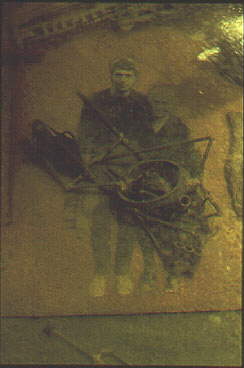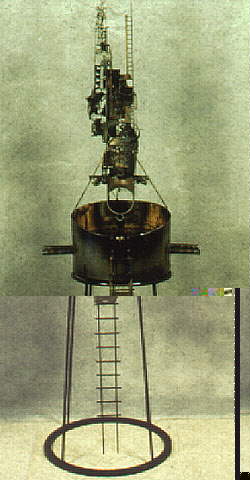
 Sculptor Gagik Aroutiunian, an instructor in the Homewood Art
Workshops, left the Soviet Bloc in 1980 as a refugee. In the
years since then, he has watched from afar as ethnic cleansing
has devastated the land and the people he once knew. In "The
Traveler and His Road" series, says Aroutiunian, "I was dealing
with those issues." Like the other pieces in the series, the one
above was created using welded steel, and its focal point is a
large container filled with water. In the piece pictured above,
the photo beneath the water shows the sculptor with his mother.
"At the time it was taken, I didn't know it would be the last
time I would ever see her," he says. After visiting her son in
Canada, where he was living at the time, she returned home and
was soon after stricken with terminal cancer. Despite
Aroutiunian's repeated pleas, he was not allowed to return. He
created this piece, he says, to express his grief and also "to
pay back the love I owed her."
Sculptor Gagik Aroutiunian, an instructor in the Homewood Art
Workshops, left the Soviet Bloc in 1980 as a refugee. In the
years since then, he has watched from afar as ethnic cleansing
has devastated the land and the people he once knew. In "The
Traveler and His Road" series, says Aroutiunian, "I was dealing
with those issues." Like the other pieces in the series, the one
above was created using welded steel, and its focal point is a
large container filled with water. In the piece pictured above,
the photo beneath the water shows the sculptor with his mother.
"At the time it was taken, I didn't know it would be the last
time I would ever see her," he says. After visiting her son in
Canada, where he was living at the time, she returned home and
was soon after stricken with terminal cancer. Despite
Aroutiunian's repeated pleas, he was not allowed to return. He
created this piece, he says, to express his grief and also "to
pay back the love I owed her."The sculptor says he incorporated water in this series for several reasons. "By immersing the photos in water, you distort the image, getting different dimensions every time you look at it," he explains. In addition, "water is very abrasive, so that gradually the image will disappear." In the same way, he says, "our emotional experience is unique to each one of us, and it, too, changes and disappears with us when we die."
Aroutiunian wears earplugs, heavy protective gloves, and goggles during the active phase of his sculpting when he is welding the hot steel. "I prefer to have rock music in the background, probably because it drowns out the excessive noise of the welder or grinder and makes it more bearable," he says. Once he's finished welding, he says, "I walk around the unfinished sculpture, sometimes for hours, looking at it from different angles and distances, and touching the surfaces. This I usually do in silence, or with a favorite piece of classical music (especially Bach) in the background."
